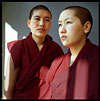Denise M. Simone
Susan E. Wagner High School English Department
A Literary View of Himalayan Women Through Religious and Cultural Texts
The Life of a Tibetan Buddhist Nun

To escape their hard lives, Himalayan women often became Buddhist nuns. While these women had to follow The Eight Strict Codes for a Fully Ordained Nun, a nun's life was preferable to many.
The following excerpts are taken from Kurtis R. Schaeffer's book, Himalayan Hermitess: The Life of a Tibetan Buddhist Nun, Oxford Press, 2004. They are from the words of Orgyan Choki who lived from 1675-1729 who spent her life in Dolpo, the highest inhabited region of the Nepal Himalayas with some mountains over 25,000 feet high. Finding works written by Himalayan women is difficult. This work is especially important as it is the oldest known autobiography authored by a Tibetan woman.
Orgyan Choki became a Tibetan Buddhist nun after a hard and seemingly unhappy childhood. Here is an excerpt from the story of her life:
Orgyan Choki herded goats and horses. She was continuously unhappy and
realized she must enter the life of an "ani," a Tibetan Buddhist
nun. She was sent to a Lama Orgyan Tenzin who became her Master. She remembers
the process:
"Then my hair was cut, my body changed, and I was given the name of Orgyan Chokyi-"Delighting in the Dharma of Orgyan."
She was given to a nun, Ani Drupchenmo, to be further trained in the ways of monastic life, who said, "You must persevere in the Dharma, for if you were to do worldly work in Person, you would be forced into corvee labor spring, summer, winter and fall without rest. As a corvee laborer you would carry water and work all the time. Meet the Dharma, take refuge, study: then you will not suffer."
Orgyan Chokyi lived her life as a nun, then a Hermitess, one who shuns the outside world. She lived alone in a cave for many years meditating in Tibetan Buddhist tradition. From her rocky cave she writes of the new freedoms and joys life brought to her from her solitude. She even composed nature poetry and poetry mean to inspire others of the importance of Dharma and of devotion to her religious practices.
Poem #1
When the lion is on the
white glacier-content.
When the vulture is above red rock-content.
When deer is on the gentle plain-content.
When the fish is under water-content.
When the tigress is in the forest deep-content.
When I the yogin am on the lonely mount-content.
Above, a sturdy cave-content.
Below, a bluegrass seat-content.
Between, the illusory body of the yogin-content.
Song sings from voice, so I am content.
Experience and realization dawn in the mind, so I am content.
Is the patron with his circle content?
Poem #2
The pleasant nook of mine,
my rocky cave,
Is a small place for meditation and reciting manis.
There is neither rain nor snow, no bad things here-
They are cut short by this one-cornered cave.
Above, no thunder-what a
joyous place.
In front, clear bluye water, like offering water,
Many trees, like a banquet display,
Water and trees aplenty-a joyful, auspicious place,
From east to west, Tibetan valleys replete with food.
Whatever I ponder here, my spiritual experience is elevated.
Solitary, alone, and looking
after reality,
Free from the chatter of the common people,
Serving religious women of a similar faith-
These are mine, Chokyi's signs of joy.
Far from the residence hall,
Free of the cross speech of the jealous kitchen mistress,
Here, the melody of mani prayers-
These are the signs of joy for this beggar, myself.
Respond to the following questions in your journal:
- What were Orgyan Chokyi's sorrows as a young child?
- What effect did her youthful problems have on the way she viewed life?
- What role did her parents play in her early development?
- How does weaving provide a metaphor for her early life?
- What effect does Ani Drupchenmo have on Orgyan Chokyi?
- How does her early life compare to her position as a meditative nun?
- How does Orgyan Chokyi use nature metaphors in poem #1 to describe her life as a Hermitess?
- How does the last line of Poem #1 differ from the rest of the poem? What do you think she means?
- After re-examining Poem #2, describe what you imagine her cave to be like.
- How is the cave being used metaphorically?
- Why does she call herself a "beggar" in the last line?
- What do these two poems say about monastic life?
%20of%20kunsangnuns.jpg)
This site was created by .... at the NEH Summer Institute "Cultures and Religions of the Himalayan Region," held at the College of the Holy Cross, Summer 2004